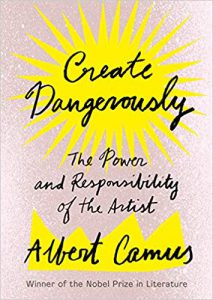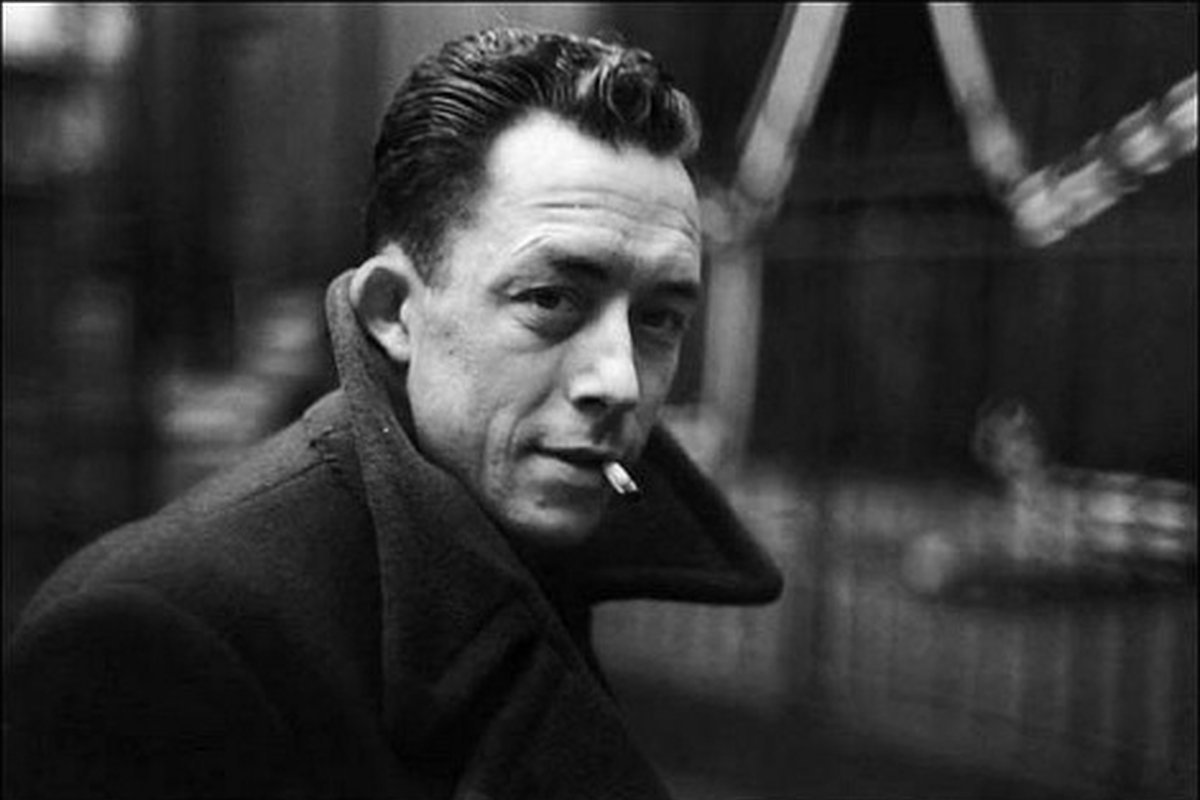Art
Create Dangerously: Albert Camus and the Power and Responsibility of the Artist
For Camus, great art develops between the two chasms of frivolity and propaganda, where every step forward is a dangerous one.

On December 14, 1957, only four days after he had delivered his acceptance speech for the Nobel Prize in Literature, Albert Camus gave another speech in Sweden, this time at Uppsala University, called “Create Dangerously: The Power and Responsibility of the Artist,” in which he argued, “To create today means to create dangerously. Every publication is a deliberate act, and that act makes us vulnerable to the passions of a century that forgives nothing.”

Exchange century for internet and you’ll know why Vintage has just rereleased this speech as its own pocket book in a new translation by Sandra Smith. These are dangerous times to create art. Which is also to say, these are the best times to create art.
But what makes these times dangerous anyway? After all, Camus gave his speech only a decade after WWII when fascism had almost conquered Europe, and the Soviet Empire was just beginning its rule over half the continent that would last the next half a century. In today’s West, this idea of “danger” seems—to use one of Camus’s favorite words—absurd by comparison. The danger one experiences as an artist in the West pales in comparison to what an artist might experience in a country like Iran or China. After all, opprobrium on social media is hardly comparable to the punishment faced by dissidents living in a theocracy or dictatorship. And yet—whether or not the times are really that dangerous, they certainly feel that way for anyone who wishes to express themselves freely. In the contemporary West, you are highly unlikely to be jailed or to lose your life for making art, but you might lose your career or your reputation or both.
We have all read the articles by now. The attempts to erase artists whether they be artists of the present or the artists of the past. Two recent examples of attempts to discredit revered artists in death come to mind—a report about an art teacher instructed by his principal to stop teaching Picasso, and a New York Times op-ed that asked, “Is It Time Gauguin Got Canceled?” (Cathy Young offered the correct answer to that second question on Twitter.)
No, it's time you all fucked off https://t.co/T9kIvYSsCj
— Cathy Young 🇺🇸🇺🇦🇮🇱 (@CathyYoung63) November 19, 2019
It has only been a few weeks since the media was seized by moral panic over Joker (which ended up backfiring when it became the highest grossing R-rated film ever). Comedians are denounced for their routines. Actors are denounced for the parts they accept.
Such attacks, of course, are nothing new. Nevertheless, as Camus suggests, in the “very midst of the sound and fury of our times: rejoice.” In times of adversity, artists are “awakened from their sleep.” And although art has always been dangerous, has always been under fire, has always been considered a threat to the stability of the social order, making art feels dangerous again and that is a good thing:
…if art is not a dangerous adventure, then what is it, and what is its justification? No, free artists cannot enjoy comfort any more than free people can. Free artists are those who, with great difficulty, create order themselves…Perhaps there is no peace for an artist other than the peace found in the heat of combat.
“Comfort,” according to Camus, is not the answer to creating great art (nor, I would add, to living a great life). Which is not to say its opposite always creates meaningful art either. But it is in risk that “true artistic freedom lies”:
Freedom in art is worth very little when it has no meaning other than assuring that the artist has an easy life. For a value, or a virtue, to take root in any society, we must not lie about it, which means we must pay for it, at every possible moment.
These are tense times and in the long run that will only benefit art. It is hard to imagine the countercultural revolutions of the sixties without the rigidity of the fifties. Just like it is hard to imagine the Renaissance without the Inquisition. Or punk without disco.
For Camus, great art develops between the two chasms of frivolity and propaganda, where every step forward is a dangerous one. He warns both against what he sees as the superficiality, or frivolity, of “art for art’s sake” and propaganda, or “lies of the realists.” These two ideological positions for artists, only restrict their freedom:
The value that is most vilified today, is most certainly the value of freedom. Thinking people—I’ve always thought that there are two kinds of intelligence, intelligent intelligence and stupid intelligence—hold as a doctrine that freedom is nothing more than an obstacle on the path to true progress. But such solemn stupidities could only be put forward because for one hundred years, consumer society made an exclusive and unilateral use of freedom, considering it a right rather than an obligation and not fearing to use the principle of freedom to justify actual oppression—and as often as possible. From that point onward, is it truly surprising that such a society wished art to be not an instrument of liberation, but rather an exercise of little importance, simple entertainment?
The term “art for art’s sake” is vague (just as the term art is) and can be interpreted in many subjective ways, but for Camus I take it to mean a superficial art, or safe art, in the service of “simple entertainment” or “pleasant distraction.” He further defines it as a formal art, one that when “created outside of society cuts itself off from its living roots.”

On the other side of this ideological coin, is social realist art, which Camus says should “admit its roots and that it is the twin brother of political realism.” He sees it as an art with an agenda that destroys the freedom of the artist, and contributes little to art in the false way it depicts reality. Because its focus is idealistic, not realistic, it inevitably ends up as propaganda with “good and evil people,” sacrificing art for what the artist believes is the superior goal of social justice:
In sum, it temporarily suppresses art so it may first support justice. When justice exists, in a future that is still unknown, art will be reborn…
Today, pressure may be put on artists to toe the line ideologically in their art at the risk of social and career suicide. This type of pressure can intimidate artists to no longer work in the pursuit of truth, but rather for the “good” of society (which in fact, does not accomplish what it intends). It can discourage artists from exploring taboo subjects and become one of the biggest threats to their freedom. For Camus, art seeks to understand, not to judge, and the best works end up, “baffling all judges.” The role of the artist is not as a “preacher of virtue”:
What writer would from now on in good conscience dare set himself up as a preacher of virtue? For myself, I must state once more that I am not of this kind. I have never been able to renounce the light, the pleasure of being, and the freedom in which I grew up. But although this nostalgia explains many of my errors and my faults, it has doubtless helped me toward a better understanding of my craft.
But perhaps the biggest struggle artists face is the one within. Camus warns that we must not to be tricked by the societal pressure to see art as a “deceitful luxury.” After all, questions could be raised: should art really matter in times of great political struggle? Is an art that seeks to explore universal truths about humanity just a luxury if it is not serving the moment in the name of social justice? This type of questioning or attacking the “principle essence” of art can threaten artists’ self-confidence. On the other hand, it might also stir up the necessary tension to push them to create dangerously:
And so, perhaps, if we listen closely amid the din of empires and nations, we might hear the faint sound of beating wings, the sweet stirrings of life and hope. Some will say that hope is carried by a nation, others by a person. But I believe quite the reverse: hope is awakened, given life, sustained, by the millions of individuals whose deeds and actions every day break down borders and refute the worst moments in history, to allow the truth—which is always danger—to shine brightly, even if only fleetingly, the truth, which every individual builds for us all, created out of suffering and joy.
It is no surprise to say that frivolous art and social realism are also the two most common types of art today. These types of art are the safest, after all, and so are most often pushed and promoted by the mainstream. But as Camus suggests, if we listen closely, we just might hear the stirrings of the next William Shakespeare—or the next Sex Pistols. For Camus, truth is always dangerous, but he reminds us that, “Danger leads to becoming exemplary, and every type of greatness, in the end, has its roots in taking risks.” It is, ultimately, the responsibility of artists to fight this battle and keep art alive. The greatest hope lies in artists’ obligation to their own freedom. Not to mention, the greatest reward.






